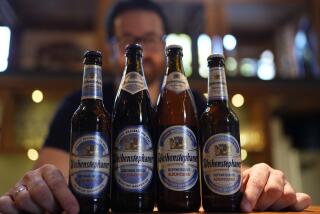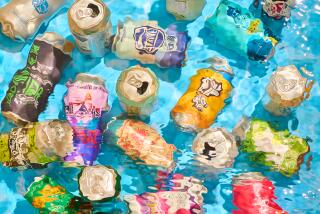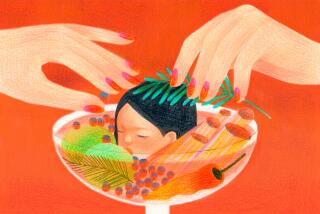Vintage brews kick in
- Share via
HERE’S a holiday gift concept: a bottle of beer -- given in the same spirit as a special wine to be put aside to age.
Yes, beer for laying down: There are, in fact, beers that improve with age. A few even carry a vintage year on the label.
We’re talking about certain high-alcohol beers: strong ales, barley wines, abbey ales, saisons, bieres de garde and Christmas ales.
This is the season for these rich, alcoholic brews -- which would put you out of commission pretty fast if you quaffed them at a thirsty summer picnic (though the Belgians somehow manage to drink their saisons and bieres de garde in summer). It’s traditional to sip them slowly in the evening during the darker, colder seasons of the year. “Winter warmers,” a lot of people call them.
Nearly all age-worthy beers are ales, and they’re particularly dark ones. Unlike porter or stout, which get their color from being made from roasted malts, these are dark because they have a particularly high concentration of malt. They’re the equivalent of a highly “extracted” wine, because they use up to three times as much malt per gallon as regular beer.
In effect, they’re a concentrate of beer. This gives them what winemakers call structure. Along with strong extract, they contain plenty of hops, a preservative, and up to three times as much alcohol as ordinary beer. So while an everyday lager starts to go bad after about three months, these rich, strong, almost syrupy brews have the stuffing to survive and even improve for years.
Barley wines are the most alcoholic and age-worthy of the strong ales, some of them reaching 14% or 15% alcohol. Christmas or winter ales are seasonal releases. The spices they contain are not only festive but can add to the interest as they age. Abbey ales, bieres de garde and saisons are Belgian and French styles also made by American craft brewers. (See box.)
The idea of age-worthy beers may seem exotic, but that’s bound to change. Anheuser-Busch recently joined the trend -- started in this country by Anchor Brewing’s Old Foghorn 30-odd years ago -- by issuing its own 8.5% alcohol beer, Brew Masters’ Private Reserve, which is vintage-dated and comes in the sort of large bottle used by many Belgian ales intended for aging.
But on second thought about that holiday gift idea, if your friend doesn’t have a sense of humor, maybe you should think twice before getting out the wrapping paper. West Coast brewers lavish their weirdest, most extreme names on their strongest, most age-worthy beers: Bigfoot, Old Crustacean, Old Numbskull, Double Bastard. Not to mention Hairy Eyeball and its even grosser cousin Eye of the Hairball.
They’re all luscious beers, mind you. On the other hand, when you give wine, you never have to explain not to take the name on the bottle personally. (Unless that’s what you intend, of course. Robert Rogness at Wine Expo in Santa Monica tells of a customer who sent an extra-large bottle of Double Bastard Ale to her soon-to-be ex-husband.)
A quirky business
THOUGH these beers still represent a small fraction of beer sales, craft brewers consider them the highest achievement of their art and relish the challenge of making them.
“Barley wine is a quirky beer to make,” says Greg Koch, chief executive of Stone Brewing. “It stresses the brewery to the maximum -- it pushes the limit of bitterness and alcohol.” Ordinary beer is fermented for a week or so, but a barley wine such as Stone’s Old Guardian often spends months in the fermenter in order to convert all possible sugar into alcohol. Brewers have little tricks to keep the fermentation going, such as rolling barrels around to “wake up” the yeast.
Unlike, say, a young Cabernet, these strong beers are always drinkable when released. Tasters find malt and hop flavors in them, obviously, and also fruits, spices, fresh bread ... you can feel them struggling to describe the seductive flavors that slowly emerge from the powerful maltiness.
What happens when the beer ages? It depends on what kind you’re talking about. The lighter ones become rounder and mellower, while the really strong ones develop totally new flavors, the way wine does.
Sierra Nevada Brewing’s brew master Steve Dressler says his Bigfoot Barleywine Style Ale acquires sherry notes with age. “The hops really subside -- they’re the first thing to go -- and the malt becomes more pronounced. It develops some dried-fruit, raisiny type flavors and aromas, and you get a sweeter maltiness. It’s more like a Port than a beer by that time.” Some people detect more exotic flavors such as chocolate and tobacco in old barley wines.
Sang Yoon, owner of Father’s Office in Santa Monica, has been tasting aged Anchor Christmas Ale for years. “Every year it’s a different recipe, and [the vintages] change over time. They start out really powerful, bright and spicy, then they become nutmeg-y and nuanced, then cocoa notes come out.”
Samichlaus, the Swiss barley wine-strength lager that is one of the strongest beers in the world (14%), is powerfully malty but elegant and balanced when young. I recently tasted a bottle of the 1996 (Samichlaus is always vintage-dated) and found that it had developed a strong chocolaty note. It was like a chocolate malt with a kick.
People have been brewing strong ales for centuries, despite the effort and expense. But since the repeal of Prohibition in the early 1930s, the American taste has trended to light, pale lager beers -- the lighter, the better.
The ale revival had to wait for the craft brewing movement. In 1975, pioneer brewer Fritz Maytag produced both the first barley wine and the first Christmas ale in this country at Anchor Steam Brewing in San Francisco. Anchor has produced Old Foghorn, a barley wine, and Our Special Ale every year since.
At least 20 California craft brewers now make beers in one or both of these styles, and they include big names such as Sierra Nevada, Stone, AleSmith Brewing, North Coast Brewing and Anderson Valley Brewing. Stone, in keeping with its “extreme” image, makes a strong ale named Double Bastard (10% alcohol) and a 10.8% stout as well as Old Guardian and the Vertical series. Mad River Brewing has been making its John Barleycorn barley wine for 15 years and Lagunitas Brewing has made Olde Gnarlywine for 12. In addition, a number of brewpubs such as Taps Fish House & Brewery in Brea make their own barley wines and Belgian-style strong ales.
Winter ales are mostly Christmas-oriented, but Shmaltz Brewing makes a kosher Hanukkah ale, He’Brew Monumental Jewbelation. This year it contains 10% alcohol, not to mention 10 kinds of hops.
Stone’s Vertical Epic is a quixotic multiyear project of releasing a new vintage every 13 months and one day, which began Feb. 2, 2002, with the idea that people could do a vertical tasting of all of them in 2012. “Now, whether they’ll all be good on 12/12/12 requires a crystal ball that’s beyond us,” says Stone’s Koch, “so we taste them every six months, and when one is reaching its peak, the tasting notes will have a ‘drink now’ note.”
Would that more breweries provided the same service. If you’re curious, you can read the Vertical Epic tastings to date, along with those of other age-worthy Stone beers such as Old Guardian, at www.stonebrew.com/tasting/notes/index.php.
Tricks of the trade
AS usual, West Coast brewers have been having their experimental way with the concept of age-worthy beers. “We’re playing around a lot now,” says Sierra Nevada’s Dressler, “aging beers in Bourbon barrels.” At Lagunitas, Tony Magee makes an annual ice beer (this year’s brew is named B4K) that concentrates an ale into something like a barley wine by freezing out part of the water.
“The major issue in storing beer, like wine,” says Dressler, “is having a good constant temperature, 40 to 45 degrees, without a lot of fluctuations that stress the beer.”
If you have a wine cellar (as opposed to a couple of shelves which are exposed to all the temperature changes that take place in your home during a year), that’s a good place to age beer. (By the way, many brewers recommend that beer bottles be stored upright, rather than on their sides.) Otherwise, a refrigerator is just about perfect, except for the part about that bottle taking up room.
But some people don’t mind. “Sometimes I buy two bottles of, say, North Coast’s Old Stock,” says Magee, who makes his own barley wine, Olde Gnarlywine, at Lagunitas, “and I drink one and leave the other in the fridge. So some Thanksgiving I find it there as a little treat I’d forgotten.”
The idea of laying down a treat for yourself sounds appealing. On the other hand, if you’ve never tasted aged beer, you have no way of knowing whether you’d like it.
Fortunately, a couple of bars around here age strong beers.
“I always have Anchor Christmas Ale in stock,” says Yoon of Father’s Office. “It’s not terribly high in alcohol, but it ages well in larger bottles like magnums -- the spices help preserve it.”
Naja’s Place, a fun-loving Redondo Beach bar that often has live rock music, stocks a huge selection of beers; its slogan is “77 taps, 777 beers.” It has a number of aged beers in bottles and North Coast’s Old Numbskull ’05 on draft.
The Stuffed Sandwich in San Gabriel stocks hundreds of brews too. Recently, it had Double Bastard 2006, 2005 and 2001 on tap, along with Sierra Nevada Harvest Ale 2006 and 2004. It’s a funky-looking place, but its customers are serious ale-heads. Many bring their own glasses to drink particular brews.
A warning: Age-worthy beers are so malty and flavorful, it’s quite easy to ignore their alcohol content -- but they’re quite potent. They’re designed, not for chugging at a bar, but for sipping at home by the fire. Or for giving away. Preferably to somebody with a sense of humor.
*
(BEGIN TEXT OF INFOBOX)Beers that gain nuance with age
Strong ale: A stronger version of pale ale, typically 5.5% to 7% alcohol, amber in color, with a sweet, malty flavor. Bottle-conditioned strong ales -- given a dose of sugar and fresh yeast before bottling -- can improve with age. Examples: Stone Vertical Epic 06.06.06, $6, (22 oz.); Stone Double Bastard, $4.50 (22 oz.).
Barley wine: An ale with the alcohol level of a wine (8% to 14%), typically dark and syrupy with complex flavors of malt and dried fruits. Develops wine-like flavors in the bottle. Examples: Anchor Old Foghorn, $14 (6-pack); North Coast Old Stock, $11 (4-pack); Shmaltz He’Brew Monumental Jewbelation, $4.50 (22 oz.).
Christmas ale, winter ale: A seasonal strong ale or barley wine flavored with spices and other flavorings. Examples: Sierra Nevada Celebration Ale, $7.50 (6-pack); AleSmith YuleSmith Holiday Ale, $5 (22 oz.); Hoppy Brewing Hoppy Claus Holiday Ale, $3 (22 oz.).
Abbey ale: A strong ale (6% to 10% alcohol) brewed with Belgian yeasts, bottle-conditioned and often sealed with a cork. The stronger ones are labeled either dubbel (double) or trippel (triple), trippels being higher in alcohol and better for aging. Some American breweries call an extra-strong abbey-style ale a quadruppel. Examples include Lost Abbey Lost and Found, $9 (22 oz.); New Belgium Ale, $8 (6-pack); Ommegang Three Philosophers, $9 (750 ml).
Biere de garde: A style of strong ale originally brewed by Flemish and northern French farmers in February and March for drinking in summer, when the local weather doesn’t permit brewing. Pale in color but capable of aging for a couple of years. Example: Craftsman Biere de Garde (sometimes on tap at Lucky Baldwin’s in Pasadena and Sierra Madre).
Saison: A specialty of the Belgian province of Hainaut, similar to biere de garde but often with spices and more hops. Examples: Lost Abbey Red Barn Ale, $8 (750 ml); Ommegang Hennepin Farmhouse Saison, $6 (750 ml).
-- Charles Perry


